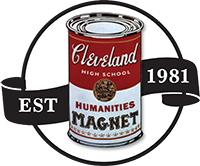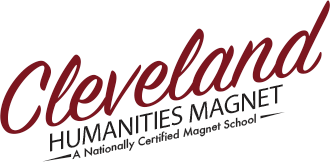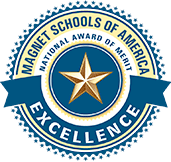Our Story
With so many challenges facing public schools today, it is rare to find a top quality high school program that, through its commitment to an integrated, interdisciplinary and stimulating curriculum and the exploration of diverse ideas, continually delivers the best academic preparation for college-bound students. Such a jewel exists in Cleveland Humanities Magnet High School, which, by any indicator, from standardized test scores, to graduation rates, to four-year college attendance rates, is one of the highest performing educational programs in the country.
According to program founder, Neil Anstead, in the early 80’s, a fortunate set of circumstances paved the way for the development of the program, from the creation of the magnet concept and interest in furthering humanities education, to the support of the school’s leadership and the coalescing of teaching staff who had a similar vision.
At the time, the Los Angeles Board of Education was under pressure to take meaningful steps to integrate students. This need gave birth to the magnet programs, which were designed to promote the integration of students from varied ethnic and racial groups and different socio-economic backgrounds. Around that same time, both the Rockefeller and Carnegie Foundations called for increased emphasis on humanities teaching. As a result, the Board of Education created two humanities programs, one at Cleveland High School in Reseda and the other at Hamilton High School in Los Angeles. Cleveland was very privileged in that the school’s administration, led then by Principal John Sanders, and Assistant Principal Ruth Ross, were not only supportive but flexible and open-minded in their willingness to see something very special designed at Cleveland. According to Neil, “We had a great deal of freedom to create something that had never been created before.” Finally, the program’s early creators held a similar vision, which, as Neil says, was truly serendipitous. They immediately agreed that the program must be based on three critical characteristics, that it be thematic, writing based, and interdisciplinary.
And, thus, in September of 1981, the program was born. While many other magnet programs tackle a narrowly defined area of study, the Cleveland Humanities Magnet education exposes students to broad experiences by addressing humankind: our development, our culture, our diversity, and our commonality.
In 1985, the Rockefeller Foundation, continually impressed by Cleveland Humanities Magnet, visited the school, along with the Los Angeles Educational Partnership, the predecessor of the Urban Education Partnership. During that visit, there was discussion about the power of the Cleveland Humanities Magnet program, and one question arose, “Can this type of program succeed in a comprehensive high school environment that is not a magnet?” The answer? Yes, but only in those cases where teachers are willing to both work hard and abandon the traditional reliance on textbooks and where there is a supportive administration.
Providing a high quality humanities education demands that Cleveland Humanities Magnet High School hire highly qualified teachers with knowledge of and experience in several humanities disciplines, including art, philosophy, literature, and social institutions. They must be open to coordinating their subject matter in order to develop an interdisciplinary curriculum fundamental to the program. In the program’s initial stages, a small staff served a group of 10thgrade students, with an emphasis on themes, an historical interdisciplinary approach, vocabulary development, and writing. Now, nearly 30 years later, the magnet has grown to include grades nine through twelve, adding one grade each year. The program now serves nearly 900 students in all four grades, offering interdisciplinary classes, known as CORE classes, with an emphasis on history, philosophy, art, and literature. Teachers write the curriculum, and no textbooks are used with a mandate that everything that is taught and everything they prepare must challenge and engage the students.
Development of the program was augmented with the support of grant monies that also built relationships between the magnet and outside educational organizations. The first of these grants, a National Humanities Faculty grant, partnered Cleveland Humanities Magnet with California State University, Northridge, a relationship that continues today. This grant allowed the magnet to bring scholars from around the country to help further develop the curriculum. Relationships have also been forged with such institutions as the J. Paul Getty Museum with a focus on enhancing art-centered curriculum.
Given its important integration goal, Cleveland Humanities Magnet found creating an “honors” program a difficult challenge in its early iteration. It needed a means to preserve the integrity of the integration program, while challenging students with higher demands and new ways of approaching instruction. The solution was the creation of an honors contract between students and teachers, which was in place for three years, at which point the entire Cleveland Humanities curriculum was declared an honors curriculum. Since then, the program has been further enhanced by requiring all 11th and 12th grade magnet students take two Advanced Placement courses. In fact, often students opt to take even more.
While the interdisciplinary nature of the program breeds inquiry and sparks dialogue and debate, the magnet curriculum also helps develop critical thinking skills. Its subject matter encourages students to suspend their beliefs in order to better examine the rationale and support for those beliefs. Ultimately, the program helps students explore their own perspectives and those of others, not as a means to change beliefs or align them, but rather to help discuss them as a critical thinker. Much of the program is tied to writing and compositional skill, and many assignments culminate in an essay. Students take an interdisciplinary midterm and final examinations that ask them to bring together everything they have learned on a specific theme and portray it in a cogent manner, analyzing and critiquing abstract concepts, principles, and theories. Many report that this approach has prepared them well for the exams they take in college.
College-bound students have found a Cleveland Humanities Magnet education a sizable asset as they emerge with a strong academic background no matter the field they pursue. The program’s emphases on critical thinking and writing, coupled with course offerings in philosophy, art, literature, and world history that are presented in an integrated fashion, offer a depth and breadth of learning that is atypical in other high schools. In fact, many professional schools, such as schools of medicine, law, and business, are particularly attracted to students with this sort of academic breadth and insight.
For many reasons, the magnet has captured the attention of outside organizations that see the program as a standard bearer and model for other humanities programs. In fact, Cleveland Humanities Magnet is the founding school and model curriculum for the Humanitas program, established with support of the Urban Education Partnership. Humanitas, which was created to promote the growth of interdisciplinary, thematic humanities instruction for urban students, now works with hundreds of teachers in almost every LAUSD high school, giving teachers opportunities for further professional development and collaboration. In fact, hundreds of teachers have come to Cleveland to attend Teacher Training Institutes, where they learn to develop thematic, interdisciplinary, and writing-based curricula. As a result, teachers and students come together to enrich a true academic community. Humanitas is now a network of more than 400 teachers working in interdisciplinary teams in 37 small schools at 26 LAUSD high schools.
Staying true to its goal of integration, Cleveland Humanities Magnet takes it to the next level, by ensuring that the program, and the curriculum, also reflects the diversity of the population it serves. As one of the most diverse cities in the world, Los Angeles provides very few opportunities for diverse groups to develop a common community. In this case, Cleveland Humanities Magnet does not “track” students into classes based on their ability levels, since that approach often yields further segregation. Rather, the program maximizes the ethnic and racial diversity of its student body by integrating it as part of the curriculum, respecting and addressing differences in lifestyle and outlook. This transcendence of ethnocentric attitudes is key to the study of the humanities since one must learn about other cultures and other people before learning about one’s own culture. The diverse Cleveland Humanities Magnet student body helps make that possible.
Proudly, with all of the changes that schools have experienced over the past 33 years, Cleveland Humanities Magnet continues to maintain the program’s integrity. According to Neil, “We know when we have succeeded: When the kids are happy and know they are getting something truly special; when our teachers are intellectually challenged and never stop learning themselves; and when the parents are happy. It can’t get any better than that.”


